The new year has arrived and with it new marketing goals and a new motivation to step up your company’s social media advertising.
And when those big goals come up, you want to put the most effective ads in your arsenal out there.
That’s where we come in.
We’ve gone through our archives to find some of the most powerful Facebook advertising strategies available.
Even as Facebook has made tweaks to its ad platform and companies have tried every trick in the book to reach customers, these strategies are still as relevant as ever.
That’s why they’re the most powerful Facebook advertising strategies, after all.
Whether you want to optimize for mobile, improve customer targeting, or finally nail your retargeting campaigns, there’s something in here for you.
Each strategy is tried and tested, so you know it will help you reach your marketing goals.
So go ahead — browse our list and get those creative juices flowing. We’ve linked each strategy to a post with more information on how to execute, so when you find one you want to try, you’ll be able to get started right away.
There’s nothing stopping your company from recharging its Facebook marketing for 2018 anymore!
1. Use A Hybrid Facebook Advertising Strategy
We live in a time where audiences use multiple devices to spend time online. Customer journeys might start while users are on their desktop researching a new product and end on a mobile device like a tablet or cell phone when they decide to buy.
That’s why advertising can’t focus on one type of platform. Even though data shows that more people spend time on their mobile devices than ever before, desktop usage is still very high — so you need to optimize ads for both desktop and mobile in your upcoming ads to maximize your reach.

Focusing on reaching customers through many platforms can raise your customer awareness. According to the famous copywriter, Eugene Schwartz, there are five levels of customer awareness:
- Unaware – your audience is completely unaware of your product and brand and are not looking for a solution because they haven’t identified that they even have a problem yet.
- Problem Aware – your audience is aware that they have a problem and are beginning the search for a solution.
- Solution Aware – your audience has found a solution but not your product.
- Product Aware – your audience has found your product, and they understand how it works to solve their problem.
- Most Aware – your audience has closed the loop — they’ve found a solution to their problem and believe your product is the best one to get the job done.
Each level of awareness indicates a person’s understanding of your product and how it serves to help fix a problem. An omnichannel strategy that incorporates desktop and mobile outreach strategies acts as a guide for customers using each platform based on their level of awareness.

Here we see each of the stages — note how mobile and desktop are incorporated into the strategy. Customers typically start their customer journey on one device and end it using another, which means your ads should be specific to each stage of awareness.
For example, mobile ads should highlight the problem people have and the solutions that are available. By the time people get to most aware, your desktop ads should focus on validating why your product is the best option available.
2. Create A Strong Pay-Per-Click Strategy To Increase Revenue And Site Visits
With Facebook ads, you pay every time someone clicks on your ads — pay-per-click (PPC). A strong Facebook advertising strategy takes this idea and gets more people to click on ads. The more clicks your ad gets, the better your chances of funneling people to your site are, and therefore the higher your revenue potential from that ad.
A strong Facebook advertising strategy uses more than one PPC strategy so that even if one underperforms, there’s another one in place to compensate.
One example of a strong PPC strategy is A/B testing. When you create your ad, use Facebook’s split testing feature to test ad visuals. Visuals are a powerful communication tool. 75%-90% of ad performance can be attributed to visuals.
To measure the performance of your visuals, keep the ad copy the same in both versions swapping only the images. Whichever ad performs the best – gets the most click-throughs and purchases – that’s the one to run with. Also, test variations of the “winning” ad to see if things like image placement or graphics drive up clicks even more.
3. Run A Competitive Analysis
Once you have a good understanding of the types of ads your audience respond to, it’s time to branch out. Run competitive analysis to understand the preferences of your competitors’ customers. Use this as an opportunity to figure out what your competitors’ audiences respond to and customize your ads to stand out.
The resulting data will help you identify opportunities to meet specific customer needs. Your ads should highlight the solution you offer and why it’s the best one for customers.
Whole Foods is a popular grocery store chain, but until recently, their prices were beyond what average shoppers felt comfortable paying. Green Chef’s competitive analysis revealed that while Whole Foods customers enjoyed the product selection and freshness, they were less thrilled about the price. This was Green Chef’s response:

For your ad, based on the results of your analysis, call out the problem your audience is trying to solve and one-up the current solution with your product. Green Chef confirmed Whole Foods as the brand of choice for the audience but then took it a step further by explaining that Green Chef customers get the same benefits and get products delivered to them, including four free meals when customers order two.
4. Incorporate Facebook Messenger ads
Since Facebook introduced Messenger, the platform has grown to one of the most powerful ways to reach and interact with audiences. Add to that the fact that customers expect instant answers to their questions — and Facebook Messenger offers customers a direct link to you — and you have an open channel to offer really targeted ads.
The main difference between this type of ad and other ad types is the call-to-action. Instead of guiding customers to a Facebook page or website landing page, Facebook Messenger ads invite customers to start a conversation.

You can set up pre-programmed responses based on popular questions or comments customers you receive. This way your ad works to engage customers and offers them the information they need quickly. Consider this, over 2 billion messages are sent between Facebook Messenger users and businesses every month! With this much communication, it’s no wonder customers expect a quick response.
5. Find The Right Frequency Balance
Nothing’s worse for a customer than seeing an ad over and over and over again. Over time, the ad loses it’s effectiveness because customers either ignore it or get frustrated by it and avoid the brand.
The most effective ads don’t appear more than five times to the same customer. Any more than this means you’re heading towards a higher cost-per-click (CPC) and lower click-through rate (CTR).
To avoid this headache, decide on frequency specifications during ad creation. Set the frequency by telling Facebook how many times an ad should show up for each customer, let’s say five times. Then set the action. This tells Facebook what you want it to do once five views have been reached. Set this to “turn off all ad sets” so that the ad stops showing for each customer once the limit’s been hit.
Your Facebook advertising strategy should guide customers and create an experience that encourages them to complete a desired action, such as buying something or giving you their email address. Experiment with different frequencies to find the balance between a comfortable CPC and CTR for your campaigns.
6. Maximize Conversions By Targeting Brand Aware Audience
Just because your audience finds your brand doesn’t mean they’re aware of what it does or how it solves their problem. In order to maximize conversions, use ads that target a “warm audience.” These are people who are familiar with your brand and what it does. They might have encountered your product in passing when someone mentioned it, but they haven’t tried it for themselves yet.
(Side note: If your audience isn’t warm yet, check out strategies #9 and #12 on this list to find out how to warm them up.)
Maximize the conversion of warm prospects by creating custom audiences based on engagement. For example, target people who’ve liked posts on your Facebook page or left comments on your Instagram pictures.
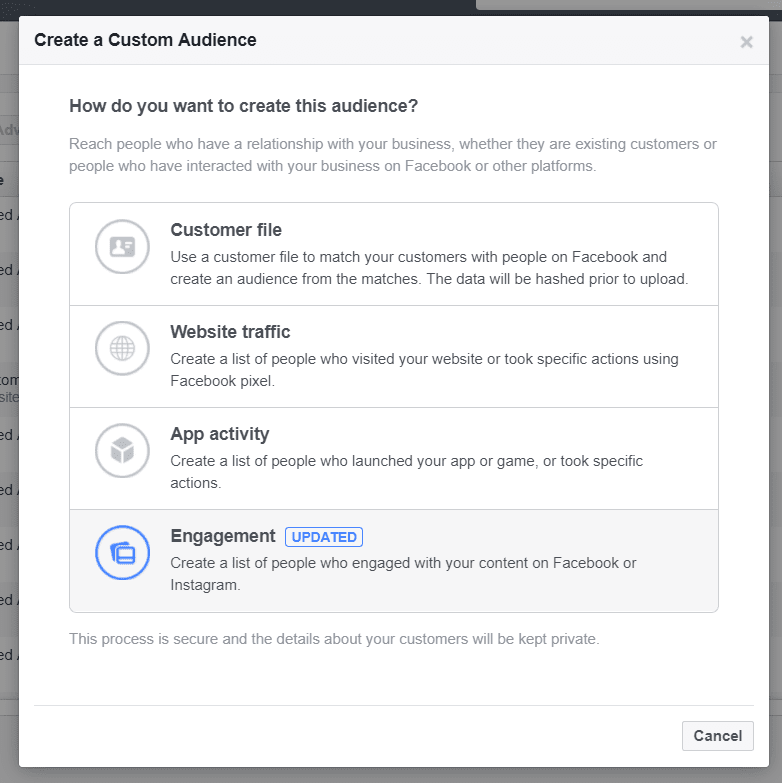
From there, all you have to do is use your copy to get these folks to convert and buy. For example, keep it short and sweet, use conversational language and use buzz words like “benefits” or “guarantee” to guide people to convert. Because they’re already familiar with what you do and offer and have shown some interest through engagement, this is the easy part.
7. Create Evergreen Facebook Ads
Depending on your business, you might decide to run ads weekly, bi-weekly, or monthly. But even though your ads run frequently, it doesn’t mean that you have to start from scratch every single time. This is time-consuming and not required. A better approach is to take “old” ads and repurpose them to make them more engaging.

- Awareness Campaigns. These campaigns target people who are most likely to engage with your brand. Facebook awareness campaigns are designed to share your brand story with this audience. To get started, include product highlights like new features. Use your awareness campaign ads to increase engagement and sales.
- Lead Generation Campaigns. Once people know who you are, the next step is to get their information, like an email address. To do this, offer value to your audience, so they are engaged with you and receptive to further communication — think e-books, webinars, and free samples.
- Conversion Campaigns. Use conversion campaigns to take these leads you just collected and convert them into sales. Here’s where you close the deal with a super targeted value proposition: exactly what makes you better than the competition.
Once you’ve chosen your evergreen strategy, make any necessary tweaks to already-made ads. You might be surprised to find how much you can get out of an old favorite with just a few minutes of work to set a new campaign and CTA.
8. Use Geo-Targeting For Facebook Ads
Back in the days of early advertising, marketers didn’t have a lot of options for where they’d target customers. There were a few channels on TV, newspapers, and magazines. Marketers had to wait for customers to engage with them before sharing their message.
Fast forward a few decades and things have changed to allow marketers to be more proactive. Geo-targeting is a great advertising strategy for getting your message in front of customers. Geo-targeting works by serving up relevant ads based on where prospects are located. The result is timely, hyper-targeted ads that get customers engaged.
Let’s say you have a fitness app and want to target people who spend time at gyms. When you create the audience for your ad, enter the address of a specific location. For example, if there’s a location with a lot of gyms or studios in the area, enter an address in that neighborhood.
If you have a physical store, enter your address into the location field so that every time people in your ideal audience enter the area you’ve specified, they see your ads.
You can choose how wide of a radius you want to target — depending on how many people you want to reach. You’ll notice that at the right side of the edit audience screen, “potential audience” will adjust to show how many people your ad can reach. Refine the audience specs further by filtering age and gender. Now, specific people who spend time in the area you’ve highlighted will see your targeted ads.
9. Create Buyer Personas
In order for any Facebook advertising strategy you choose to work, you have to know your audience. We’ve all heard the Meredith Hill saying, “When you speak to everyone, you speak to no one”. It’s true — not everyone in your audience is going to care about what you have to offer. It’s harsh, but it’s the reality.
A better approach is to create a range of personas based on ideal customers. This will help you create targeted ads that resonate with people. Each persona should include details about customer needs, demographics, and psychographic attributes – things like values and opinions. This is the foundation for forming buyer personas.
Pro tip: Don’t create buyer personas based on assumptions. Do the research to make sure that the personas you’re targeting actually care about what you offer.
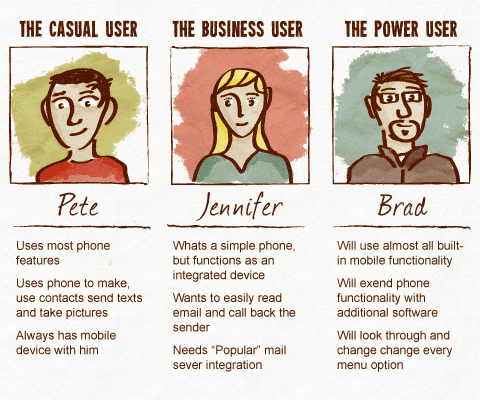
Once you analyze the data you’ve captured — by using, for example, an analytics tool like Amplitude to learn how people use your website and products and then compare the findings against each other — segment your audience based on shared characteristics, behaviors, and expectations. When it comes to Facebook ads, use this information to refine your Audience Insights.
On the left, you can create custom audiences by entering the data you’ve already collected — for example, audience location, age, and gender. In this example, age and gender are segmented, and you can compare where your audience falls (in blue) to the rest of users on Facebook (grey area).
Click save at the top of the screen to save the resulting data to Power Editor. This simplifies the ad creation process because your ad — using Power Editor — will pull from these buyer persona audiences to help you create specific ads for specific groups. Bottom line: you get more bang for your buck.
10. Manage Facebook Ad Performance To Combat Ad Fatigue
Despite how hard athletes train for their sports, there’s a point where their maximum effort no longer affects their output. Simply put, they get tired and don’t finish off with the same energy level as they started with. The same thing goes for your ads. Over time, ad performance drops.
As devastating as this sounds, you can curb its effects. To help keep your ads as effective as possible for as long as possible, you need to optimize your ads so that ad performance doesn’t suffer. This means keeping CPC at a level that meets your needs — meaning ads are affordable and effective. Fix CPC before your ad achieves maximum reach.
To track your ad performance, check out your ad report which you can access by clicking on “Ads Reporting” in the Ads Manager drop-down menu.
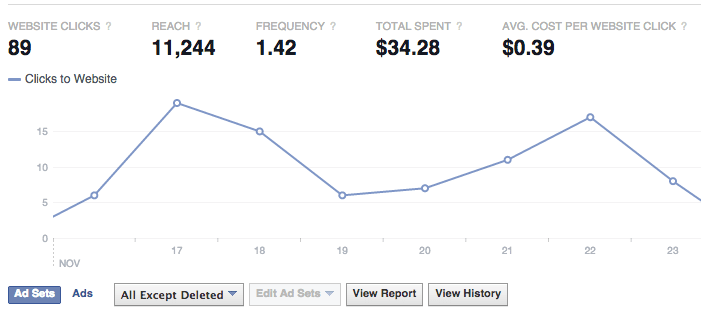
Here, you can see clicks to the website climb in the first few days of an ad. From there – November 17 – clicks start to drop. When you see a drop like this, play around with ad placement. For example, ads can be placed anywhere on Facebook — in-stream videos, newsfeeds, or instant articles — or Instagram, Messenger, and Audience Network.
If ad performance has started to decline in one of these placements, Facebook will automatically adjust your budget so that fewer ads appear in one area and more appear in another. For example, if Messenger ads aren’t performing well, Facebook will help put more emphasis on showing ads during in-stream videos. The result is ads that seem to last longer and give audiences a fresh perspective.
11. Create Internal Checkpoints To Define The Limits Of A Campaign
If your Facebook ads are the engine that helps drive your marketing forward, then your Facebook advertising strategy is the mechanic that says when the car is good to go. Just like with engines, you need to stay on top of the metrics you track — like CPC and CTR — to see how they interact with each other or to spot problems.
Just as mechanics will check out different parts of an engine to ensure it’s working properly, your strategy should include checkpoints that define the limits of your campaign. For example, let’s say CPC is out of proportion with CTR — that is, you’re spending a lot on your ads, but barely anyone is clicking through to your landing page. There’s a problem that’s been identified and needs to be managed.
Set up a list of limits for the metrics you track and convert them into “if this, then that” scenarios. This way, you create a manual of sorts to help solve problems quickly when specific triggers appear. For example, in our CPC vs. CTR scenario, you might:
- Run a new ad with new copy that focuses more on the problem your product fixes vs. all of the features it offers.
- Adjust your audience in follow-up ads. It’s possible that targeting is off, so the “wrong” people are seeing your ad and not reacting.
- Adjust the length of your campaign. Perhaps it didn’t run long enough so it didn’t reach as many people as it could have.
Checkpoints ensure that you make these adjustments in a timely manner so that your ads are as successful as possible. Not doing anything means you end up wasting time and money.
12. Use Facebook Remarketing Tactics To Reintroduce Brands
When we talk about remarketing, we’re not talking about marketing to your audience through different channels, like showing ads to a user on Facebook and then again on Instagram. That is retargeting, and it focuses on using more than one channel to attract the same person. A lot of managers feel comfortable with this strategy because they’re reaching the same people without overwhelming them on one platform.
But retargeting’s cousin is remarketing. Remarketing is when someone leaves a comment on one platform, say your Facebook page, and you send that person a follow-up message on the same platform. Some managers feel hesitant about this because it seems like you’ll cause ad fatigue, but 2018 is the year to conquer that fear.
Remarketing targets people who’ve interacted with your brand on some level and uses advertising to encourage them to come back and finish what they started. It’s not a spammy way of trying to grab attention. Cart abandonment is a popular remarketing opportunity, but others include:
- People creating a profile but quitting before it’s complete.
- Customers browsing product pages but leaving without buying anything.
- Potential customers signing up for a free trial but never logging back in to try the product.
When you create your custom audience for your remarketing ad, specify what action people have to take to trigger remarketing ads. For example, if someone visited a specific page on your website within a set amount of time, they’ll automatically receive the remarketing ad:

13. Use Emojis To Connect With Audiences
When you think of emojis, Facebook ads might not be the first thing that comes to mind. However, we’ve found that ads with emojis included in the copy have resulted in “a 30%-40% higher click-through rates and 20% lower CPC than regular posts.” That’s probably not what you’d expect, right?
However, we’ve run tests, and the results show it’s true.
In the ad above (right) with the emojis included, the text stands out more. The reader’s attention is drawn to the top of the ad and then the bottom. Even though the ad on the left cost less than the one on the right, the emoji ad resulted in a 12% boost to CTR.
But you can’t just slap in any old emojis — random usage could hurt your brand more than help it. Consumers are looking for emojis that:
- Feel authentic and not forced
- Are in line with the emojis they use themselves
- Don’t massively distract from what they’re reading
To get the right emojis, A/B test a few variations to determine the a good ratio of text to emoji and the types of emojis used. You want to grab attention but still be taken seriously.
14. Focus On Facebook Lead Ads
Your ads shouldn’t hinder your audience’s experience while using Facebook. For example, people scrolling through their news feed might see an interesting ad. But because they don’t want to leave the platform, they scroll past it instead of clicking it — usually thinking they’ll return to it later.
Whenever possible, use Facebook lead ads to keep people in the app. When people see an interesting ad and know that they won’t be forced to leave Facebook, they’re more likely to sign up for your product or service because it happens in the app and not on an external site.

Facebook lead ads have the potential to boost conversions because they don’t force users to abandon what they were doing in the platform before seeing the ad.
15. Incorporate Social Proof Into Facebook Ad Design
The whole reason most people log onto Facebook every day is to see what their friends and family are doing. Facebook makes it easy by offering features that let you see what your friends have “Liked” or where your friends are hanging out.
It’s this drive for social inclusion that lies at the center of social proof. When you incorporate social proof into your advertising, it minimizes the fear people have of trying something new and unfamiliar.
The ad above uses a testimonial to sell the product. If you’re trying to get leads, use phrases like “join 100,000 people who’ve already said yes.” This shows people new to your brand that other people are using it and enjoying it. As a result, potential customers are more likely to want to try your product.
Wherever you can incorporate authentic content from people who really love your product, including things like top ratings on Yelp or Amazon, you build that implicit social trust with your audience.
16. Incorporate Video Ads Where Possible
Whether it’s live video or uploaded content, video on Facebook is becoming more popular. It’s a great way to get people to stop and take notice, and the proof is in the numbers. Facebook generates more than 8 billion video views every single day. And that number continues to climb.
Use video in your ads to explain the story behind your product. Use this as a chance to be creative so that your ad stands out and is memorable. Facebook now offers a tool called Creative Apps that lets you use any of your brand pictures and videos to tell your unique brand story.
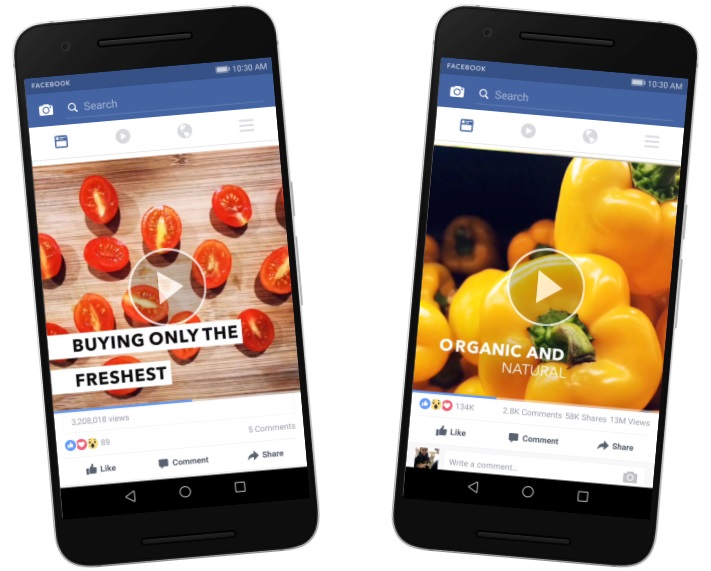
Use Creative Apps to make your videos and pictures more engaging. For example, you can access the following design apps to supercharge your videos:
- Legend – lets you choose unique text fonts to incorporate over videos or pictures
- Videoshop – this is a video editor with enhanced video editing capabilities
- Quik – lets you animate text and manage the transition between pictures or videos
- Hyperlapse and Boomerang – lets you create time-lapsed videos and short loop videos
- Vidlab and Piclab – lets you create slideshows or video mashups and add elements like filters
You know your audience best so experiment with different features until you find the combination that leads to the most conversions, click-throughs, or sign-ups. Keep in mind that your audience will likely watch your video without sound so make sure that the images and video you use are easy to understand. For example, use the Legend app to add a little text to further clarify your message.
Get 2018 Started On The Right Note
To recap, here are the 16 most powerful Facebook advertising strategies to try in 2018:
Strategy #1: Use a hybrid Facebook advertising strategy
Strategy #2: Create a strong price per click strategy to increase revenue and site visits
Strategy #3: Run competitive analysis
Strategy #4: Incorporate Facebook Messenger ads
Strategy #5: Find the right frequency balance
Strategy #6: Maximize conversions by targeting brand aware audience
Strategy #7: Create evergreen Facebook ads
Strategy #8: Use geo-targeting for Facebook ads
Strategy #9: Create buyer personas
Strategy #10: Manage Facebook ad performance to combat ad fatigue
Strategy #11: Create internal checkpoints to define the limits of a campaign
Strategy #12: Use Facebook remarketing tactics to reintroduce brands
Strategy #13: Use emojis to connect with audiences
Strategy #14: Focus on Facebook lead ads
Strategy #15: Incorporate social proof into Facebook ad design
Strategy #16: Incorporate video ads where possible
Pick two or three to test and incorporate more as you get comfortable. Over time, you’ll figure out which strategies work best for you and your audience.

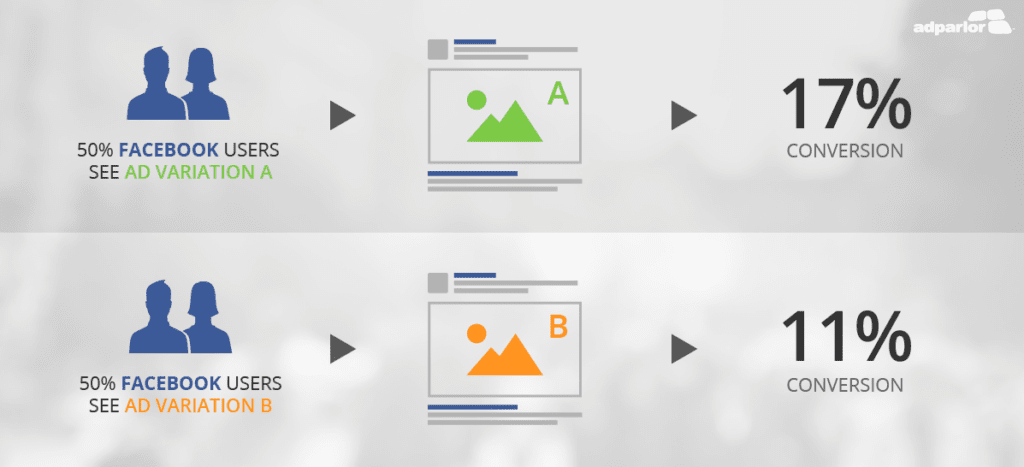

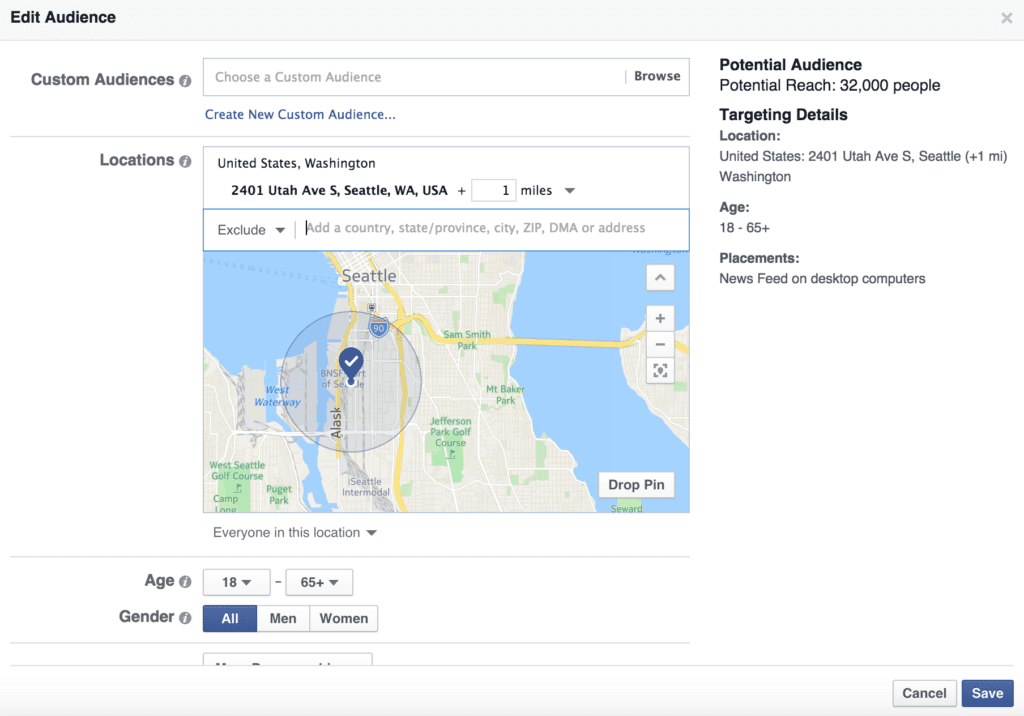
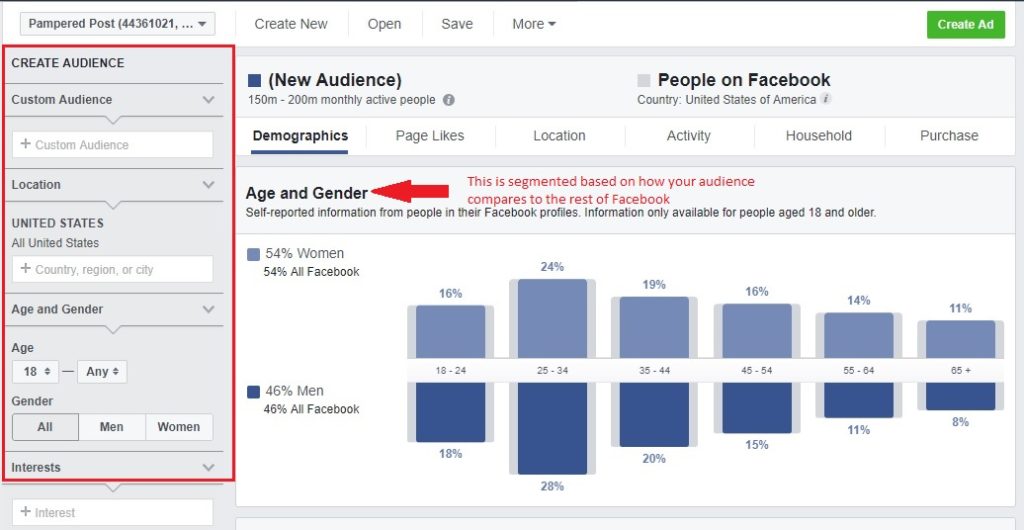



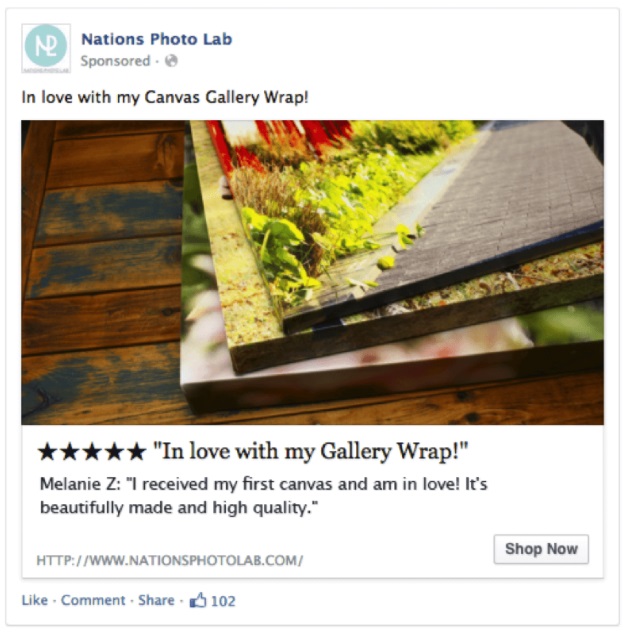
Great strategies. I will be using this on my new websites. Thank You.
Hey this is really awesome post! I never seen these kind of post. You did very well . Thanks for sharing great information.
Kudos to you Andrew, for writing such a great article! Facebook has indeed made it possible to expand the horizons of geo-targeted ads. However, in light of recent disputes, Facebook has removed some third party data partners. When choosing an agency, companies should be cautious about this fact. Companies that use deterministic first-party data should be sourced. All data should be ethically sourced and permission-based, in order to have a healthy relationship with the big social media giant.
Nice! Thank you.
Nice. Its really helpful and too much advance tips for our Facebook advertising.Thanks to you for sharing with us.
I found your article very useful, solid recommendations, well-written.
Nice Article!
This digital marketing strategy helps me to get more traffic to my website from Facebook. In this blog you have provided best social media marketing strategies. Thanks for sharing the valuable information.
Nice blog.
Got to know more about digital marketing and strategies.
Very Nice Article!
This digital marketing strategy is well-written nd helps me to get more traffic to my website frm my fb page. In this you have provided best social media marketing strategies. Thanks for sharing the valuable information.
Great strategy will use in my blog
Nice Article
Thanks
Thanks so much for sharing these awesome facebook advertising strategies.
Very well presented. I will be using these strategies with my FB ads. TY
Just as you recommend using geo targeting for Facebook, I think you should also use it on your CPC campaigns. We’ve found we burned through a lot of money with non-geo-targetted CPC advertising. This helps focus the campaign and your ad dollars. What do you think?
Thanks!
Chris
Excellent writing!
I think that another vital element of Facebook promotions, Lookalike crowds engage organizations to target new possibilities dependent on their present clients. So, you can focus on a Facebook crowd that looks like your most faithful clients or individuals who’ve effectively drawn in with your promotion crusades. On the off chance that your Facebook advertisement procedure is revolved around prospecting and mindfulness, Lookalike crowds are for you.